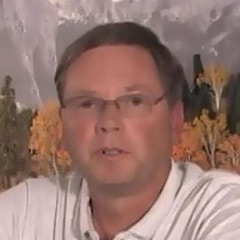
Scenery Techniques on the Denver, Front Range and Western
Doug TagsoldRand Hood explains that one of the things that Doug Tagsold discovered when working on his layout is that the Rio Grande went through very different territories. Here he shows a high plateaued desert of Colorado where the railroad takes off from Bond and is heading from Steamboat Springs and Craig.
One of the products that he uses to create this module is “Great Stuff” expanding foam spray. When it is finally cured, after about twelve hours, it is still a little bit pliable. This allows Rand to be able to go back in after he has sprayed it and built up areas, and tear it into the shapes to create an eroded look.
The materials he uses is plaster and dirt mixed in equal proportions to create a dry base. This can be mixed with glue and water if needed. In a container he has a mixture of 50-50 white glue and water. He then scoops the plaster base directly into the mixture to create a kind of paste. He adds a little bit at a time and lets it dissolve.
One thing that Rand adds to the mixture is a product from Arizona Rock & Mineral Company. They have crushed stone powders in different colors. A little of this powder in Sedona Red is added to the paste. He makes sure to be careful and not use too much because it tends to tint the paste quickly. To color the mixture, he adds a quarter of a tsp along with Limestone to add grit and texture. About a full teaspoon of the Limestone powder is also added.
The plaster will firm the mixture quite fast. He dabs and stipples chunks of the paste onto the scene to create a sandstone look. As an igneous rock, the round particles created look very realistic when it is allowed to dry. Next he shows how to add broken pieces of plaster to the scene. For more helpful scenery tips or model railroad mountains and rocks, visit Model Railroad Academy.
